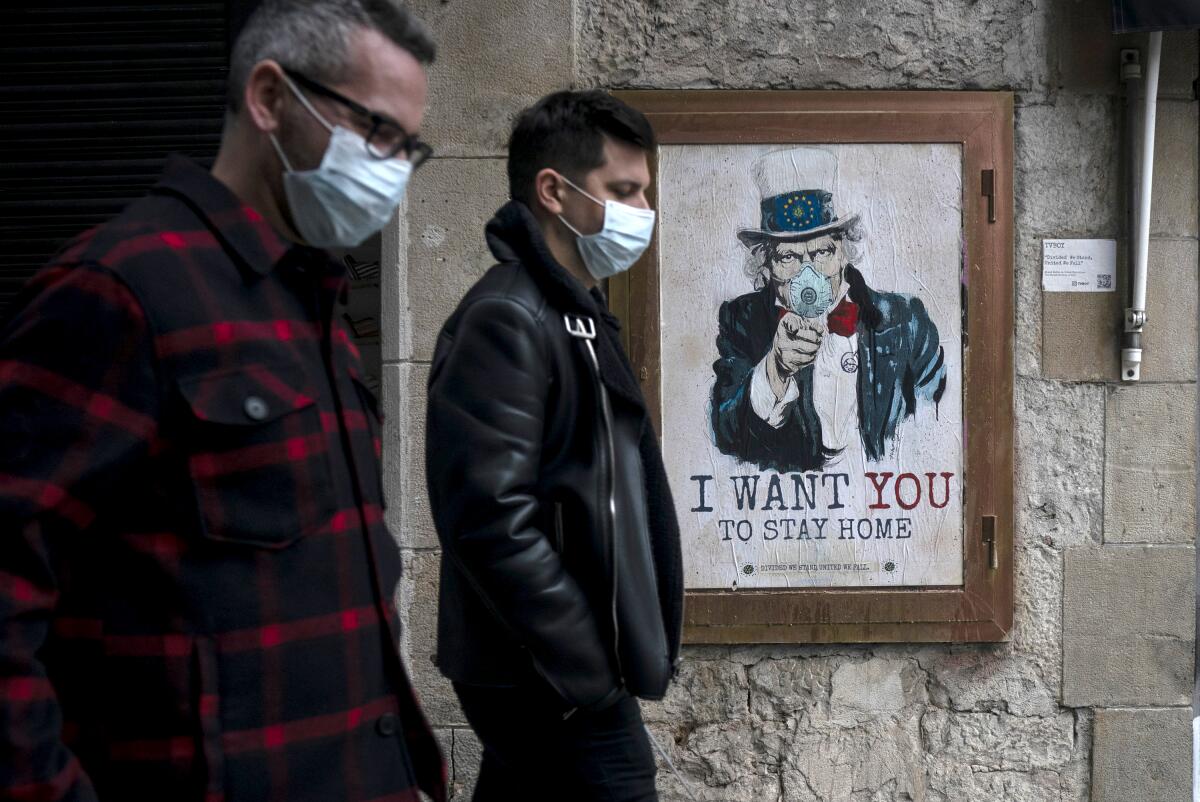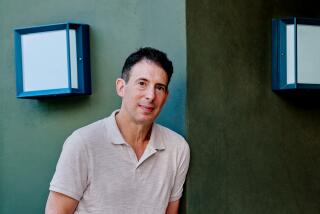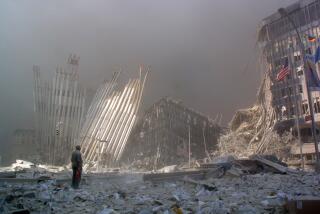Column: The six stages of pandemic emotion

It’s been a year since California registered its first COVID-19 case and 10 months since we recognized the magnitude of the threat.
We responded by hoarding toilet paper, as if it were a talisman that would protect us from an enemy we didn’t yet understand.
I interviewed Costco shoppers stockpiling survival goods, during that panicked run on the grocery stores. Their carts — loaded with pasta, toilet paper and bottled water — crowded the aisles, jammed checkout lanes and littered parking lots.
They told me they were worried we would be locked down for months. I wanted to laugh at how ridiculous that seemed.
This is America, after all. We’re smart and strong enough to get ahead of this virus, I thought. We would hold it at bay until it fizzled out.
That was 428,000 deaths ago. It’s painful to acknowledge now how naive I was then.
And even a death toll that staggering fails to convey the scope of our struggle, the breadth of our loss, and the ongoing toll on our emotional health.
Being isolated from family and friends, failing at learning online, jobless and about to lose your home, grieving a loved one you didn’t get to hug one last time. There are so many ways to hurt during this pandemic; no one is exempt.
And yet we keep soldiering on, clinging to each illusory ray of hope that our nightmare is nearing its end.
We’ve been keeping our distance and masking our smiles for so long, I’m shocked when old photos pop up on my phone of me, unmasked, at a neighbor’s birthday party, wrapped in a group hug. Now, even in my dreams I worry when the people aren’t wearing masks.
As the pandemic drags on, it feels like we’re moving through a process akin to psychiatrist Elisabeth Kübler-Ross’ five stages of grief.
Her therapeutic recovery model for people grieving a loss begins with denial, and that’s where I started last spring: This would be no different from the overhyped Ebola scare in 2014, I thought.
Then stores closed, work stopped, schools shut down — and anxiety took hold. There was so much about COVID-19 we didn’t know then, I was afraid to leave the house. I imagined the virus could kill you if you so much as touched anything that hadn’t been sanitized. And of course, sanitizer was sold out everywhere.
Gov. Gavin Newsom ratcheted up the worry in March when he suggested that 25 million Californians could be infected by July. (The reality was considerably less disastrous: fewer than 3.3 million cases have been confirmed since he made that claim.)
By April there were mask mandates, social distance rules and medical tests that could tell if you needed to quarantine because the virus had infected you. Knowledge felt like power, and rules were the tools that liberated us a bit from COVID-19’s vise-like grip. Restrictions loosened, anxiety eased, we made peace with a captor we’d begun to arm ourselves against. Stage three — acceptance — set in.
But things quickly shifted, as fall ushered in a holiday season that would shake us up, break our hearts, and fracture our resolve. A record-setting surge of COVID-19 infections and deaths would result.
For some, that fourth stage might be called rebellion. You throw off the shackles; travel, eat out and meet up with friends. You bend the rules to hug your grandma, in a kitchen crowded with relatives who haven’t seen each other for months.
But for others, it was the pathway to despair. That’s the stage that enveloped me, as I moved through the season unmoored, separated from the people I love. My daughters and I had agreed not to travel for the holidays; the risk of illness dictated the sacrifice. So I spent my birthday, Thanksgiving, and Christmas by myself at home.
We chatted on FaceTime and I got to see my grandbabies, but that didn’t ease the pain. The loss of holiday rituals that have anchored our family for decades only made me feel more alone. It began to feel like the terrorist stalking us had won.
That’s when my fifth stage — anger— began to kick in. Sometimes I wish I had something to punch. And I know I’m not alone.
Our long-running battle with the pandemic has spawned such ambient anger, a new word has been coined to describe the mix of frustration, fear and resentment we feel. We’re “pangry” these days — and that simmering rage is showing up in unhealthy ways, including a stunning jump in homicides, a surge of domestic violence reports, and an endless stream of viral videos of public brawls.
There’s so much to be angry about: The loss of lives, the fracturing of families, the uneven burdens we bear. The dysfunction of a state unemployment agency that was swindled out of billions of dollars and left millions of Californians on the brink of ruin. The line-cutters and partygoers and people too dense or self-centered to bother masking up. The clueless and malevolent man who occupied the White House and squandered so many opportunities to lead during the pandemic’s first, crucial year. The state and local politicians who favor press conferences over preparedness. The fumbling that has put vaccines out of reach for too many vulnerable people.
There’s so little to ameliorate the angst we feel. No smiles from a stranger, no coffeeshop chats with friends, no visits from neighbors, no hugs from grandkids. And every time we feel like we’re making progress, the virus mutates and sends in fresh troops.
And yet ... there are rays of light ahead. We’re turning a corner, with a new president and a slew of new vaccines on the horizon.
The new administration takes this pandemic seriously. After nine long months of presidential neglect, there’s a lot of ground to make up. But President Biden’s team is working feverishly to deliver the resources we need.
The medical advances generating new vaccines are putting our target of controlling the virus in striking range this year.
And our state, county and city are acting with more urgency — learning perhaps from the mistakes they’ve made. When our vaccine scheduling apparatus faltered last week, experts came together and partnerships were made. New vaccine venues and smarter websites appeared in days, instead of weeks.
There is still much to do to manage this pandemic equitably. There’s not enough outreach in Black and Latino neighborhoods, where infection rates are high and vaccine delivery lags. Too many elderly people aren’t able to access vaccines because the sign-up technology flummoxes them. And too little is being done to help essential workers, who often live in dense, overcrowded conditions where the disease can easily spread.
Still, this is an endeavor unlike anything we’ve ever faced. There’s no map or algorithm to guide our steps; it’s a perpetual balancing act, with no way to mitigate inevitable grief. We’re all just trying to get by, one day at a time.
For now, though, I’m also determined to bask in every bit of sunshine I can find.
I was blessed with a chance to be vaccinated with my age group this week, when a friend sent me the sign-up link, and another walked me through the bewildering process of finding an open spot. That wasn’t the end of their good-deed doing; they helped cleaning ladies and gardeners and elderly neighbors and their parents’ homebound friends make appointments for vaccinations too.
We may not be able to hug one another, but our bonds can be strengthened by all we’re going through.
I thought of that on Thursday morning, as I stood in the cold with hundreds of other seniors at a park in San Fernando, in the northeast San Fernando Valley, home to some of the city’s highest COVID-19 infection rates. The line had begun to form hours before the first 8 a.m. vaccine slot, and the wait for some might be hours long.
But the process was efficient, the seniors were patient, the helpers were thoughtful and kind. And as we took our seats — socially distanced at picnic tables and on folding chairs — to wait out the possibility of complications, strangers struck up conversations and laughter bubbled up all around me.
I know we are not yet in the clear, but it feels like we have finally reached a point where we aren’t giving ground in this fight.
I felt inexplicably joyous when I left, comforted by the new ache in my arm. I’m heading into the sixth stage of pandemic emotion, and I’m going to label it hope.
More to Read
Start your day right
Sign up for Essential California for news, features and recommendations from the L.A. Times and beyond in your inbox six days a week.
You may occasionally receive promotional content from the Los Angeles Times.







